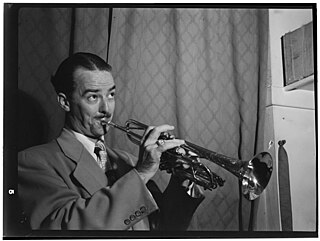Related Research Articles

Joseph Vernon "Big Joe" Turner Jr. was an American blues shouter from Kansas City, Missouri. According to songwriter Doc Pomus, "Rock and roll would have never happened without him". Turner's greatest fame was due to his rock and roll recordings in the 1950s, particularly "Shake, Rattle and Roll", but his career as a performer endured from the 1920s into the 1980s.

Anthony James "Lonnie" Donegan was a British skiffle singer, songwriter and musician, referred to as the "King of Skiffle", who influenced 1960s British pop and rock musicians. Born in Scotland and brought up in England, Donegan began his career in the British trad jazz revival but transitioned to skiffle in the mid-1950s, rising to prominence with a hit recording of the American folk song "Rock Island Line" which helped spur the broader UK skiffle movement.

Aaron Thibeaux "T-Bone" Walker was an American blues musician, composer, songwriter and bandleader, who was a pioneer and innovator of the jump blues, West Coast blues, and electric blues sounds. In 2018 Rolling Stone magazine ranked him number 67 on its list of "The 100 Greatest Guitarists of All Time".

James Andrew Rushing was an American singer and pianist from Oklahoma City, Oklahoma, U.S., best known as the featured vocalist of Count Basie's Orchestra from 1935 to 1948.

Oscar Pettiford was an American jazz double bassist and composer. He was one of the earliest musicians to work in the bebop idiom.

James Witherspoon was an American jump blues singer.

Harry "Sweets" Edison was an American jazz trumpeter and a member of the Count Basie Orchestra. His most important contribution was as a Hollywood studio musician, whose muted trumpet can be heard backing singers, most notably Frank Sinatra.

Benjamin Francis Webster was an American jazz tenor saxophonist.
The origins of rock and roll are complex. Rock and roll emerged as a defined musical style in the United States in the early to mid-1950s. It derived most directly from the rhythm and blues music of the 1940s, which itself developed from earlier blues, the beat-heavy jump blues, boogie woogie, up-tempo jazz, and swing music. It was also influenced by gospel, country and western, and traditional folk music. Rock and roll in turn provided the main basis for the music that, since the mid-1960s, has been generally known simply as rock music.

Robert Leo Hackett was a versatile American jazz musician who played swing music, Dixieland jazz and mood music, now called easy listening, on trumpet, cornet, and guitar. He played Swing with the bands of Glenn Miller and Benny Goodman in the late 1930s and early 1940s, he played Dixieland from the 1930s into the 1970s in a variety of groups with many of the major figures in the field, and he was a featured soloist on the first ten of the numerous Jackie Gleason mood music albums during the 1950s.

Kenneth Colyer was an English jazz trumpeter and cornetist, devoted to New Orleans jazz. His band was also known for skiffle interludes.

Gerald Stanley Wilson was an American jazz trumpeter, big band bandleader, composer, arranger, and educator. Born in Mississippi, he was based in Los Angeles from the early 1940s. He arranged music for Duke Ellington, Sarah Vaughan, Ray Charles, Julie London, Dizzy Gillespie, Ella Fitzgerald, Benny Carter, Lionel Hampton, Billie Holiday, Dinah Washington, and Nancy Wilson.
"Rock Island Line" is an American folk song. Ostensibly about the Chicago, Rock Island and Pacific Railroad, it appeared as a folk song as early as 1929. The first recorded performance of "Rock Island Line" was by inmates of the Arkansas Cummins State Farm prison in 1934.
George Sylvester "Red" Callender was an American string bass and tuba player. He is perhaps best known as a jazz musician, but worked with an array of pop, rock and vocal acts as a member of The Wrecking Crew, a group of first-call session musicians in Los Angeles. Callender also co-wrote the 1959 top-10 hit "Primrose Lane".

Guy Lafitte was a French jazz saxophonist.

Sam Woodyard was an American jazz drummer.
Bobby Bryant was an American jazz trumpeter and flugelhornist.

"Rock-A-Beatin' Boogie" is a 1952 song composed by Bill Haley and first recorded by the Esquire Boys in 1952. Bill Haley and the Comets recorded the song in 1955 for Decca. The song was featured in the 1956 movie Rock Around the Clock.

"Rudy's Rock" is a 1956 instrumental composed by Bill Haley and Rudy Pompilli and released as a Decca single. The song appeared in the 1956 Columbia Pictures movie Rock Around the Clock. The single peaked at #34 on Billboard and #26 in the UK on the Record Retailers chart.

"R-O-C-K" is a 1956 rock and roll song recorded and co-written by Bill Haley and released as a Decca single. The song appeared in the 1956 Columbia Pictures movie Rock Around the Clock. The single peaked at #16 on Billboard.
References
- ↑ Walker, Clinton (2000). "Last of the Red Hot Mammas". Buried Country: The Story of Aboriginal Country Music . Pluto Press. pp. 62–63. ISBN 1-86403-152-2.
- ↑ Clyde Frederick Collins. "Red Perksey & His Orchestra - Vocals by Ray Dickson - A Litle Boy Called Smiley (1956)".
- 1 2 The Age 4 June 2005 Discovered: rock'n'roll's scratchy start
- ↑ Great Australian Television: Barrier Reef, http://www.classicaustraliantv.com/BarrierReef1.htm
- ↑ IMDb: George Assang, https://www.imdb.com/name/nm0039768/, accessed 22 August 2012
- ↑ Kent, David (2005). Australian Chart Book (1940–1969). Turramurra, N.S.W.: Australian Chart Book. ISBN 0-646-44439-5.
- THE FIRST WAVE: Australian rock & pop recordings, 1955–1963 by Ross Laird (pdf)
- Australian Popular Music Recordings 1955–1969 by Ross Laird (pdf)